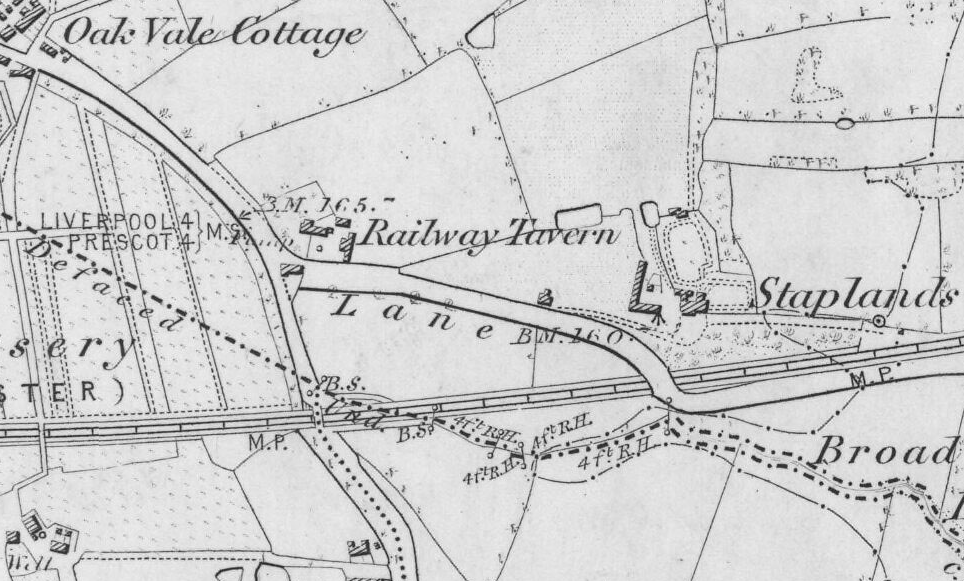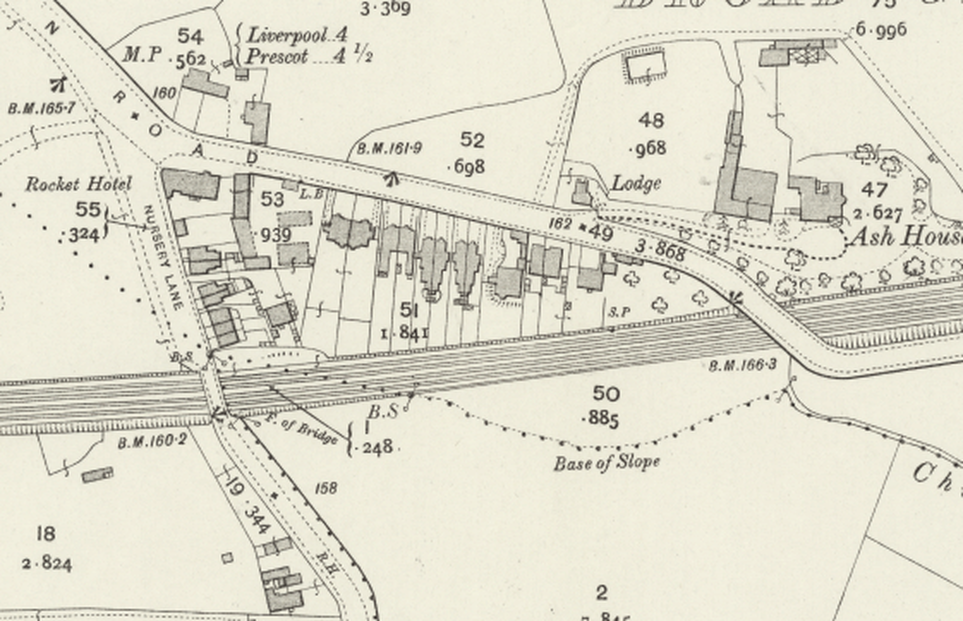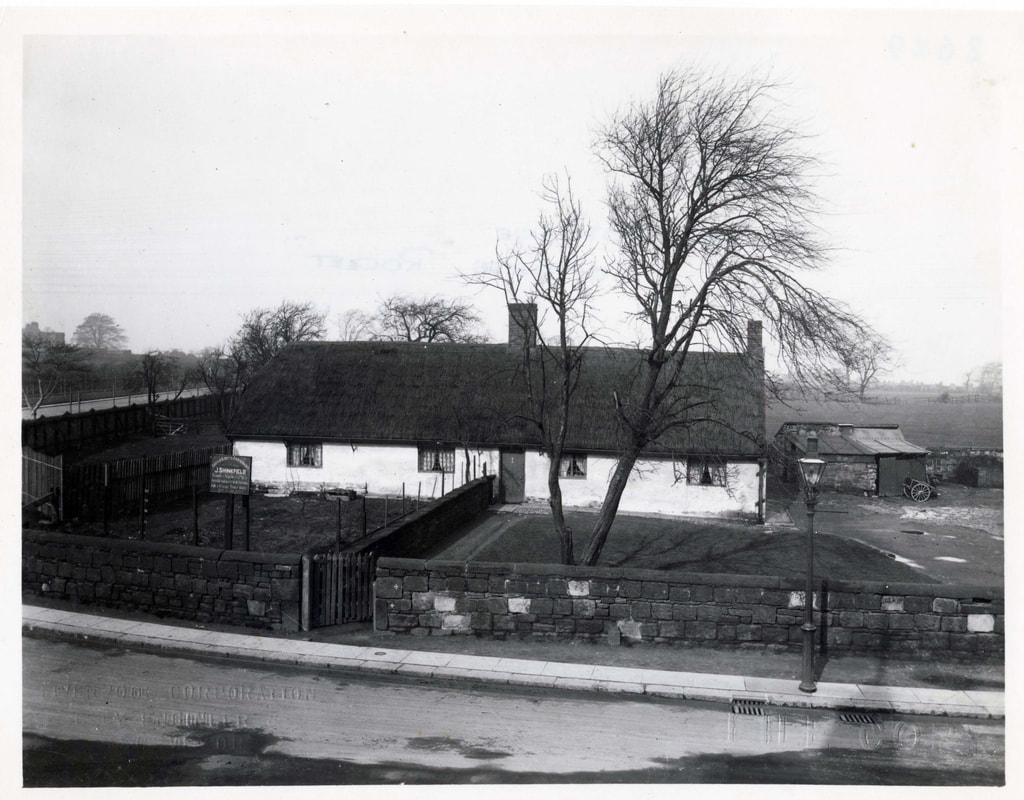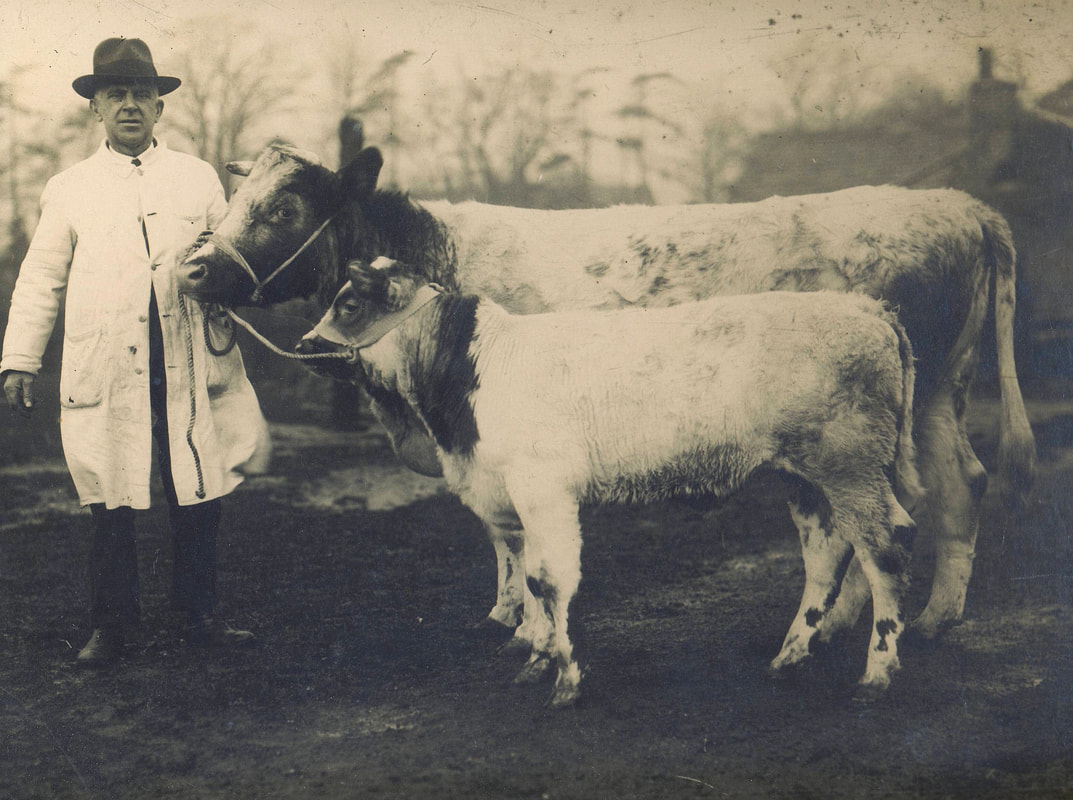I was prompted to write this piece after being contacted by Susanne Barton, the granddaughter of Norman Shinkfield. Susanne had read an article elsewhere on this site, written by Brian Phythian, that mentioned her grandfather, and she wanted to share her memories and heirlooms of her cowkeeping ancestors.
The Shinkfield cowkeepers were active in the Broadgreen district of Liverpool in the early 1900s. The area's street name and numbering went through various historical changes due firstly to the construction of the Liverpool-Manchester railway in the 1830s and then due to the creation of the city's ring road, Queens Drive, during the early 1900s. These changes can present challenges when trying to pinpoint the whereabouts of one's ancestors! To set the scene, here are a couple of old maps of the area, which illustrate some of these changes over time:
The Shinkfield cowkeepers were active in the Broadgreen district of Liverpool in the early 1900s. The area's street name and numbering went through various historical changes due firstly to the construction of the Liverpool-Manchester railway in the 1830s and then due to the creation of the city's ring road, Queens Drive, during the early 1900s. These changes can present challenges when trying to pinpoint the whereabouts of one's ancestors! To set the scene, here are a couple of old maps of the area, which illustrate some of these changes over time:
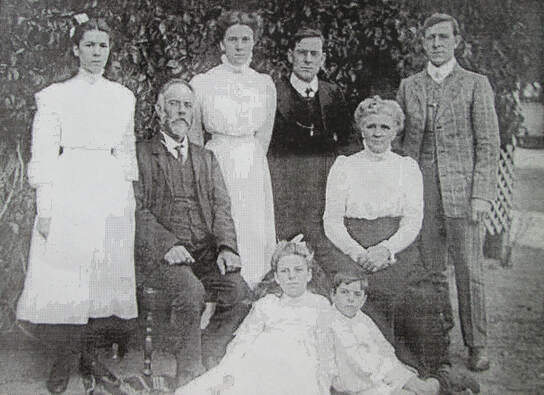 William R Shinkfield and family, after their move to Australia. (1913). Courtesy of Susanne Barton.
William R Shinkfield and family, after their move to Australia. (1913). Courtesy of Susanne Barton.
Robert Shinkfield (1830-1918) was born and raised in Norfolk, where he became a Dairyman. On 25th December 1858, he married Anna Claxton (1836-1921). Interestingly, although they were both living in Norfolk at the time, their marriage took place at St James’s Church, Toxteth, Liverpool.
Between 1859 and 1879 they had twelve children, all born in Norfolk: William Robert (1859-1945), Elizabeth Maria (1861-1867), Charlotte Rosa (1863-1865), Annie Flora (1865-1946), James Henry (1867-1959), John George (1868-1932), Norman (1869-1869), Lily Elizabeth (1871-1947), Rosa Charlotte (1873-1936), Norman Arthur (1876-1945), Harriet Bertha (1877-1925) and Horace Claxton (1879-1959).
By 1881, Robert’s eldest son, twenty-one year old William Robert Shinkfield, had moved to Liverpool and was living at 62 Windsor Street in the house of his mother’s brother, William J Claxton. Presumably, William Robert, whose given occupation was that of ‘Joiner’, was working for his uncle, who was a ‘Master Joiner’.
Three years later, in 1884, William Robert Shinkfield married Mary Woof (1863-1939) at Wesley Chapel, Stanhope Street, Liverpool. They took over a dairy at 28 AVISON STREET, which had recently been vacated by Mary’s brother, Thomas Woof. They were still at the Avison Street dairy for the census of 1891. By then, William Robert (Cowkeeper) and Mary had two children: William (6) and James (4). Also living with them were two of William Robert’s siblings: his brother John George Shinkfield (Cowkeeper) and sister Annie Flora Shinkfield (Milliner).
A year later, in 1892, William Robert, Mary and their two children emigrated to Australia, where they stayed for the rest of their lives.
Between 1859 and 1879 they had twelve children, all born in Norfolk: William Robert (1859-1945), Elizabeth Maria (1861-1867), Charlotte Rosa (1863-1865), Annie Flora (1865-1946), James Henry (1867-1959), John George (1868-1932), Norman (1869-1869), Lily Elizabeth (1871-1947), Rosa Charlotte (1873-1936), Norman Arthur (1876-1945), Harriet Bertha (1877-1925) and Horace Claxton (1879-1959).
By 1881, Robert’s eldest son, twenty-one year old William Robert Shinkfield, had moved to Liverpool and was living at 62 Windsor Street in the house of his mother’s brother, William J Claxton. Presumably, William Robert, whose given occupation was that of ‘Joiner’, was working for his uncle, who was a ‘Master Joiner’.
Three years later, in 1884, William Robert Shinkfield married Mary Woof (1863-1939) at Wesley Chapel, Stanhope Street, Liverpool. They took over a dairy at 28 AVISON STREET, which had recently been vacated by Mary’s brother, Thomas Woof. They were still at the Avison Street dairy for the census of 1891. By then, William Robert (Cowkeeper) and Mary had two children: William (6) and James (4). Also living with them were two of William Robert’s siblings: his brother John George Shinkfield (Cowkeeper) and sister Annie Flora Shinkfield (Milliner).
A year later, in 1892, William Robert, Mary and their two children emigrated to Australia, where they stayed for the rest of their lives.
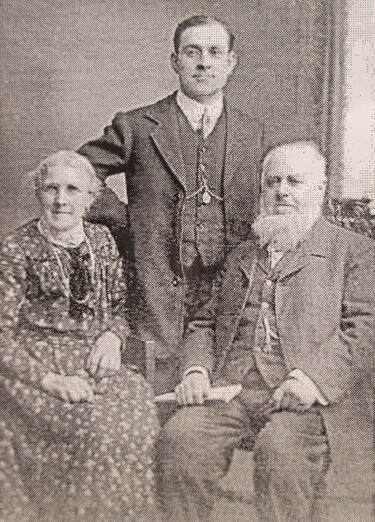 Robert and Anna Shinkfield, with grandson William Robert Shinkfield junior. (c. 1907) Courtesy of Susanne Barton.
Robert and Anna Shinkfield, with grandson William Robert Shinkfield junior. (c. 1907) Courtesy of Susanne Barton.
At the time of the 1891 census Robert Shinkfield and the remainder of his family were still living in Norfolk (near Kings Lynn), where his occupation was ‘Dairy Man’. Possibly prompted by the departure of his eldest son to Australia, Robert made the decision to follow his older children and relocate to Liverpool. As the 1894 and 1900 directories list Robert Shinkfield at 28 AVISON STREET, it appears that Robert initially took over that dairy from his son. However, by the time of the 1901 census, he is recorded as being a Cowkeeper living at 95 GAINSBOROUGH ROAD, Wavertree, along with his wife and six of his grown-up offspring: John George (33), Cowkeeper; Elizabeth (30), Dairy Manageress; Rosa C (27), Dairymaid; Norman Arthur (25), Cowkeeper; Bertha H (23), Milkmaid; and, Horace C (21), Commercial Salesman.
For the 1911 census Robert was living at 28 Heathfield Road, Wavertree, where his occupation is given as ‘Retired Cowkeeper’. His wife, Anna, and two daughters, Lily and Bertha, were living with him. When he passed away, in August 1918, the probate record gives his address as 114 Belgrave Road and confirms his given occupation as ‘Retired Cowkeeper’.
For the 1911 census Robert was living at 28 Heathfield Road, Wavertree, where his occupation is given as ‘Retired Cowkeeper’. His wife, Anna, and two daughters, Lily and Bertha, were living with him. When he passed away, in August 1918, the probate record gives his address as 114 Belgrave Road and confirms his given occupation as ‘Retired Cowkeeper’.
Two of Robert's sons, John George and Norman Arthur continued their involvement with the cowkeeping industry in Liverpool:
John George Shinkfield (1868-1932) married Mary Emma Hignett (1875-1935) at the church of St Michaels-in-the-Hamlet, on 26th February 1902. His given address was 16 St Michael’s Road and his occupation that of Cowkeeper. As this address is a mid-terrace property, it seems unsuitable for keeping cows. This suggests that John George was perhaps working for one of the other cowkeepers in the neighbourhood (of which, there were a few). Between 1902 and 1915, they had six children: Stanley Hignett Shinkfield (1902-1971), Eric Hignett Shinkfield (1905-1975), Phyllis Monica Shinkfield (1907-1973), Kenneth Hignett Shinkfield (1910-1969), Molly Kathleen Shinkfield (1911-2002) and Nancy Marion Shinkfield (1915-1985).
The 1905 directory lists John G Shinkfield living at 31 BROAD GREEN ROAD. Then, the 1911 census has him at 3 CHILDWALL PRIORY ROAD, Broad Green, where he was living with his wife and his first four children; his occupation is still that of Cowkeeper. However, it seems he was using both of these addresses, as the 1914 directory lists John G Shinkfield as a Dairy Farmer at Broad Green Road, but also gives a residential address as 3 Childwall Priory Road; Mrs Mary Emma Shinkfield is listed separately at that residence. With the development of Liverpool’s first ring road, the postal address of this residential property would later change to 3 QUEENS DRIVE, Broad Green (1925 electoral register).
The 1905 directory lists John G Shinkfield living at 31 BROAD GREEN ROAD. Then, the 1911 census has him at 3 CHILDWALL PRIORY ROAD, Broad Green, where he was living with his wife and his first four children; his occupation is still that of Cowkeeper. However, it seems he was using both of these addresses, as the 1914 directory lists John G Shinkfield as a Dairy Farmer at Broad Green Road, but also gives a residential address as 3 Childwall Priory Road; Mrs Mary Emma Shinkfield is listed separately at that residence. With the development of Liverpool’s first ring road, the postal address of this residential property would later change to 3 QUEENS DRIVE, Broad Green (1925 electoral register).
The 1926 directory lists John G Shinkfield as a Dairyman, living at 14 HIGHFIELD VIEW. Following John George’s death, in 1932, assisted by two of her sons Mary Emma continued the business and has directory listings as a Cowkeeper/Dairyman at that address up until her death, in 1935. Eric Shinkfield (Cowkeeper) is recorded there in the 1939 register. Kenneth Shinkfield (Cowkeeper and Dairyman) is recorded there in the 1939 directory, but in the 1939 register is a Dairyman and Grocer living at 5 CHELWOOD AVENUE. In the 1946 directory, Kenneth is listed as a Dairyman at 35 WEST WAY, Wavertree.
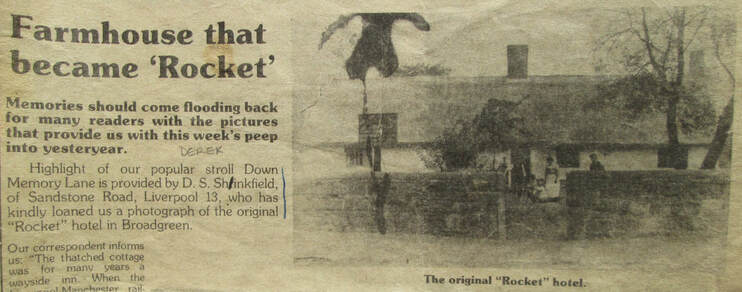
Susanne Barton kindly provided the following press cutting (of unknown date or origin) about the history of John Shinkfield's cottage on Broadgreen Road.
Our Peep into the past… Farmhouse that became ‘Rocket’
Memories should come flooding back for many readers with the pictures that provide us with this week’s peep into yesteryear.
Highlight of our popular stroll Down Memory Lane is provided by D. S. Shinkfield, of Sandstone Road, Liverpool 13, who has kindly loaned us a photograph of the original “Rocket” hotel in Broadgreen.
Our correspondent informs us: “The thatched cottage was for many years a wayside inn. When the Liverpool-Manchester railway was being built, the navvies used it a lot, and it is possible Stevenson stayed there for a time, while supervising the work on this part of the line. The inn was named the “Rocket” to commemorate this. At the time the photograph was taken, circa 1905-06, the cottage was a farmhouse, tenanted by my grandfather, John Shinkfield. His farm covered the area between Broadgreen Road and Thomas Drive and is now occupied by Rockville, Carville and Renville roads.”
Our Peep into the past… Farmhouse that became ‘Rocket’
Memories should come flooding back for many readers with the pictures that provide us with this week’s peep into yesteryear.
Highlight of our popular stroll Down Memory Lane is provided by D. S. Shinkfield, of Sandstone Road, Liverpool 13, who has kindly loaned us a photograph of the original “Rocket” hotel in Broadgreen.
Our correspondent informs us: “The thatched cottage was for many years a wayside inn. When the Liverpool-Manchester railway was being built, the navvies used it a lot, and it is possible Stevenson stayed there for a time, while supervising the work on this part of the line. The inn was named the “Rocket” to commemorate this. At the time the photograph was taken, circa 1905-06, the cottage was a farmhouse, tenanted by my grandfather, John Shinkfield. His farm covered the area between Broadgreen Road and Thomas Drive and is now occupied by Rockville, Carville and Renville roads.”
Norman Arthur Shinkfield (1876-1945), switched occupation from being a keeper of cows to being a supplier of cows – he became a Cattle Dealer. When he married Alice Mills (1882-1961), in July 1905, he was a Cattle Dealer living at 4 CASSVILLE ROAD, Wavertree. Between 1907 and 1921, they had seven children: Maud (1907-1999), Hilda May (1909-1986), Bertha Lily (1912-2006), Minnie Thelma (1914-2004), Annie Flora (1916-2010), Robert Marshall (1921-1926) and Frederick Norman (1924-1997).
By 1911 (census) Norman had moved one road along and was living at 3 EARDISLEY ROAD, still a Cattle Dealer. The cattle business must have been good, because by 1914 (directory) the family had moved to a larger house, ‘Lynwood’, on Broad Green Road. The development of the Ring Road (Queen’s Drive) through the district of Broadgreen led to various changes being made to road names and house numbers. The 1922 directory lists the family as living at ‘Claremont’, 26 BROAD GREEN ROAD. Though the 1926 directory lists ‘Claremont’ as being 80 BROAD GREEN ROAD, by 1939 (directory and register) the family is once more listed at 26 Broad Green Road.
In 1924, Norman was a judge (Fat Cattle) at the annual cattle show organised by the Liverpool and District Cowkeepers’ Association. Later, in 1937, he took second prize in a class of Cows in Calf or Milk, which was only open to Cattle Dealers. He remained a Cattle Dealer until his death in 1945 (Probate Calendar).
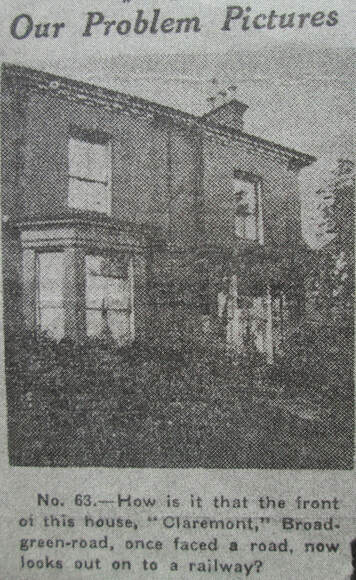 Claremont. Back-to-front House. Courtesy of Susanne Barton.
Claremont. Back-to-front House. Courtesy of Susanne Barton.
Norman’s granddaughter, Susanne Barton, shares her memories of visiting her grandparents’ house:
“Norman and his wife Alice lived in Broadgreen, in a house called "Claremont". It was number 26 and was a short distance from the Rocket Hotel. The house had the distinction of getting its photo into the local paper with the question: How come this house is back to front? It originally had its respectable frontage facing the road and the buildings where the cows were kept were tucked away at the back. However, when the railway was built it was at the very front of the original front garden and the cows' buildings (originally at the back) therefore faced directly onto the new road! Complicated. I remember visiting the house when my grandmother still lived there, after my grandfather died, and thinking what a strange way round it was. After my grandfather died his son, Fred, lived in the house for a while. I'm not sure of his exact involvement in the cattle business, but I do remember him occasionally dropping in to visit us, in Ormskirk, on his way back from the Preston market, where he went to do something to do with cows.”
Fred did indeed take over his father’s cattle dealing business and is listed at 26 BROAD GREEN ROAD in the 1946 directory, along with his mother, Alice. By 1955, yet another change to the road name led to the property being listed as 26 BOWRING PARK ROAD. After his mother died, in 1961, Fred moved to ‘Clapham’, in Grange Lane, Gateacre, but continued to operate his cattle dealing business out of 26 Bowring Park Road. He died in 1997, in Bangor, N Wales, at the age of 73.
“Norman and his wife Alice lived in Broadgreen, in a house called "Claremont". It was number 26 and was a short distance from the Rocket Hotel. The house had the distinction of getting its photo into the local paper with the question: How come this house is back to front? It originally had its respectable frontage facing the road and the buildings where the cows were kept were tucked away at the back. However, when the railway was built it was at the very front of the original front garden and the cows' buildings (originally at the back) therefore faced directly onto the new road! Complicated. I remember visiting the house when my grandmother still lived there, after my grandfather died, and thinking what a strange way round it was. After my grandfather died his son, Fred, lived in the house for a while. I'm not sure of his exact involvement in the cattle business, but I do remember him occasionally dropping in to visit us, in Ormskirk, on his way back from the Preston market, where he went to do something to do with cows.”
Fred did indeed take over his father’s cattle dealing business and is listed at 26 BROAD GREEN ROAD in the 1946 directory, along with his mother, Alice. By 1955, yet another change to the road name led to the property being listed as 26 BOWRING PARK ROAD. After his mother died, in 1961, Fred moved to ‘Clapham’, in Grange Lane, Gateacre, but continued to operate his cattle dealing business out of 26 Bowring Park Road. He died in 1997, in Bangor, N Wales, at the age of 73.
